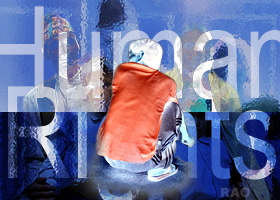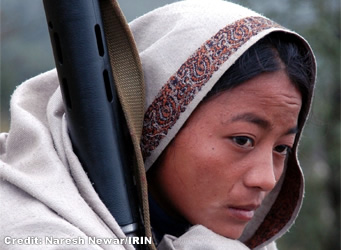|
Nepal
in Crisis 2006: Human Rights
|
|
Overview
analysis: A people's war?
|
 |
KATHMANDU,
20 February 2006 (IRIN)
Nepal's
brutal conflict between Maoist insurgents and security forces has exacted
a heavy toll on the civilian population, especially those in contested
hill districts, many of whom already live near or on the global poverty
threshold. An estimated 12,000 people have been killed since the Maoist
faction of the Communist Party of Nepal, officially launched its "people's
war" in February 1996.
 |
| A
local human rights watchdog claims that a quarter of those deaths occurred
in 2004, after an escalation in the violence following the collapse of
a ceasefire the year before.
Nepal
faced the prospect of renewed conflict in January 2006, when armed followers
of the Maoist faction of the Communist Party of Nepal ended a four-month
unilateral ceasefire. The Maoists launched their armed rebellion against
the state in 1996 and ended their latest ceasefire in response to King
Gyanendra's failure to reciprocate. Nepalis living outside the capital,
Kathmandu, remain hostage to a climate of impunity that has evolved over
the last decade. They are caught between local Maoist commanders and a
security regime that has often operated beyond the confines of the law. |
|
| Protection
crisis |
 |
 |
| Civilians,
especially those in heavily contested rural districts, have been exposed
to a catalogue of abuses at the hands of both sides. The Maoists have killed,
intimidated or coerced local government officials, such as local village
leaders, teachers and political workers. They have harassed civilians suspected
of having government or military sympathies and abducted school children
into their indoctrination programmes. They have also restricted freedom
of movement of civilians, extorted money or demanded taxes for goods and
services. This has had implications for agricultural and livestock production,
food security and market access. |
|
Equally
bleak is the record of the armed forces and police, with evidence of arbitrary
arrests, detention, disappearance, torture and summary executions. The
Nepalese army has been singled for particular criticism by the UN Special
Rapporteur on Torture. In the last two years, Nepal has also had the highest
number of disappearances reported to the UN Working Group on Enforced or
Involuntary Disappearances.
The
physical and psycho-social effects on families, children and women who
have witnessed or been subject to violations and attacks will reverberate
for years to come. Teachers and school children have been badly affected.
The head teacher of a school in Rukum district, 300 km northwest of Kathmandu,
said that children could barely concentrate on their studies for fear of
being abducted by Maoists, or being visited by the security forces. "Those
who think they are targets for abductions, or torture or mishandling, may
just leave for India," he said.
Local
human rights groups have been limited to what they can achieve in such
a hostile context. However, their morale was boosted with the arrival of
a UN human rights team in May 2005. Headed by Ian Martin, the UN's Office
of the High Commissioner for Human Rights has been tasked to monitor and
report on human rights violations related to the conflict. Martin said
that while the Nepalese army was not always happy with the mission, cooperation
was forthcoming, especially on access to detainees in army custody. "At
scrutiny here is the performance of the RNA [Royal Nepalese Army]. And
they take pride in their UN peacekeeping role - so I think we have considerable
influence," he said.
| Pockets
of vulnerability |
 |
While
aid officials have maintained there is not a humanitarian crisis in Nepal,
there is genuine concern that local conditions could deteriorate to warrant
greater assistance. Local communities were "very vulnerable, very poor
and could be pushed over from a tolerable, manageable situation into a
real crisis," said Mark Segal, conflict adviser with the Department for
International Development in Kathmandu.
It
is believed that 100,000 to 200,000 people have been internally displaced
by the conflict. Up to two million are thought to have fled the violence
by migrating to India and beyond.
Credit:
David Gough/IRIN
In
Rukum district, farmers complained that their greatest obstacle was the
ability to move freely about the district. The Maoists restricted movement,
especially to the army-controlled town. This has deprived farmers of vital
supplies, seeds, the ability to graze livestock unhindered, and most importantly,
access to the local market.
| Displacement
and migration |
 |
An
estimated 100,000 to 200,000 people are thought to have been internally
displaced. Largely from rural communities, they have fled from targeted
attacks, violence and increased economic hardship. The majority live with
relatives in temporary abodes, or on abandoned plots in district or regional
towns, or in the capital. Few statistics are available, not least because
most displaced people would not want to attract the attention of the security
forces. Up to 2 million people are thought to have left, migrating to India
or beyond.
Women
displaced by conflict were especially vulnerable. The coordinator of a
local NGO in Rukum district, said that a number of displaced women had
resorted to distilling alcohol and to being sex workers. This phenomenon
was likely to increase if the conflict continued. Human trafficking across
the border with India had also increased, according to a local NGO monitoring
movement of girls.
| Future
humanitarian action? |
 |
According
to one aid official, Nepal lay on a line between sudden humanitarian crisis
on the one hand, and reconciliation to the conflict on the other. Aid officials
have been paying close attention to political developments in Kathmandu.
Most are aware that unless there is a resolution to the political impasse,
ongoing assistance can offer little more than "a holding pattern".
It
was unrealistic to think that a major difference could be made to the conditions
of the population until there was peace, said Segal. "Peace is the thing.
It is the continuation of the conflict which is really destroying or limiting
the impact of development to improve people's lives," he said.
| Political
stand-off |
 |
Analysts
in Kathmandu have claimed that ending the tremendous suffering and misery
of the Nepali people is not impossible. Kunda Dixit, prominent editor of
the Nepali Times, said that ending the military stalemate and political
deadlock required "a bit of vision and statesmanship on the part of the
king, and some understanding on the rebel side that violence and conflict
is not going to lead them anywhere".
The
Maoists appear to have understood this message. Analysts in Kathmandu claim
that the February 2005 royal coup has presented the insurgents with a chance
to enter mainstream politics. In September 2005, the Maoist leadership
announced a unilateral ceasefire, which eased conditions for those living
in contested areas. In November, the Maoists met the seven main opposition
parties in New Delhi and agreed on a peace process that would restore democracy
and end direct rule by the monarchy. Despite peace-seeking efforts from
the united front of Maoist and other political parties by extending the
ceasefire and by holding one of the largest pro-democracy rallies ever
held in the capital in early December, King Gyanendra, failed to respond.
The Maoists curtailed their ceasefire at the end of the year resulting
in the official resumption of conflict at the start of 2006 with dire socio-economic
and humanitarian implications for the new year.
What
happens next in Kathmandu is likely to determine the course of the conflict.
The resumption of fighting between Maoist insurgents and the security forces
will have a direct impact on communities in rural districts. However, even
a protracted stalemate will pose challenges for donors and aid agencies
trying to reach the most affected. Unless there is marked improvement in
the political and military situation, the need for more intensive humanitarian
engagement may grow.
Credit
IRIN 2006
Copyright
© UN Office for the Coordination of Humanitarian Affairs 2006
[
This report does not necessarily reflect the views of the United Nations]
Integrated
Regional Information Networks (IRIN), part of the UN Office for the Coordination
of Humanitarian Affairs (OCHA).
.

|






